If you are considering strabismus surgery for yourself or your child, you have likely heard about adjustable sutures. As a strabismic adult, I did all the research on adjustable sutures before my strabismus surgery, and was lucky enough to experience getting them adjusted just a week after the operation. I am here to share everything I learned and experienced to help you be better prepared for your experience!
So what are adjustable sutures and what is it like to have them adjusted? Adjustable sutures are used in specific strabismus surgeries, especially adults or children who have had previous surgeries. The surgeon ties off the sutures in a way that allows them to come back and fine tune the eye alignement up to one week after the surgery. While effective, it is not a super pleasant experience and can be quite uncomfortable. It is definitely worth the discomfort to get better results and decrease chances of future surgeries.
To read about the controversy surrounding adjustable sutures and my personal experience of getting my sutures adjusted after strabismus surgery, read on.
Why Do Some Surgeons Use Adjustable Sutures?
There are so many unknowns with strabismus surgery, the biggest unknown is the brain. How will the brain respond to adjusting the position of the eyes? While there are patterns and surgeons with years of experience learn them, every patient and brain is different. This is especially true for patients who have had previous surgeries.
The surgeon can’t just follow an exact formula that works with every single patient, unfortunately. Each patient is unique and responds to the surgery differently.
Adjustable sutures allow for the main surgery to be performed while the patient is asleep, then adjustments can be made after the patient is awake and the brain has started responding to the new position. To read about my actual surgery click here.
My surgeon told my husband (while I was still under), that he got fantastic alignment and was happy with the result. By the end of the next day my right eye decided to turn way in. Luckily, he was able to make some adjustments one week later and I got much better alignment.
While I originally had four muscles operated on, the inside and outside of both eyes, the suture adjustment was only done on the inside of my weaker eye.

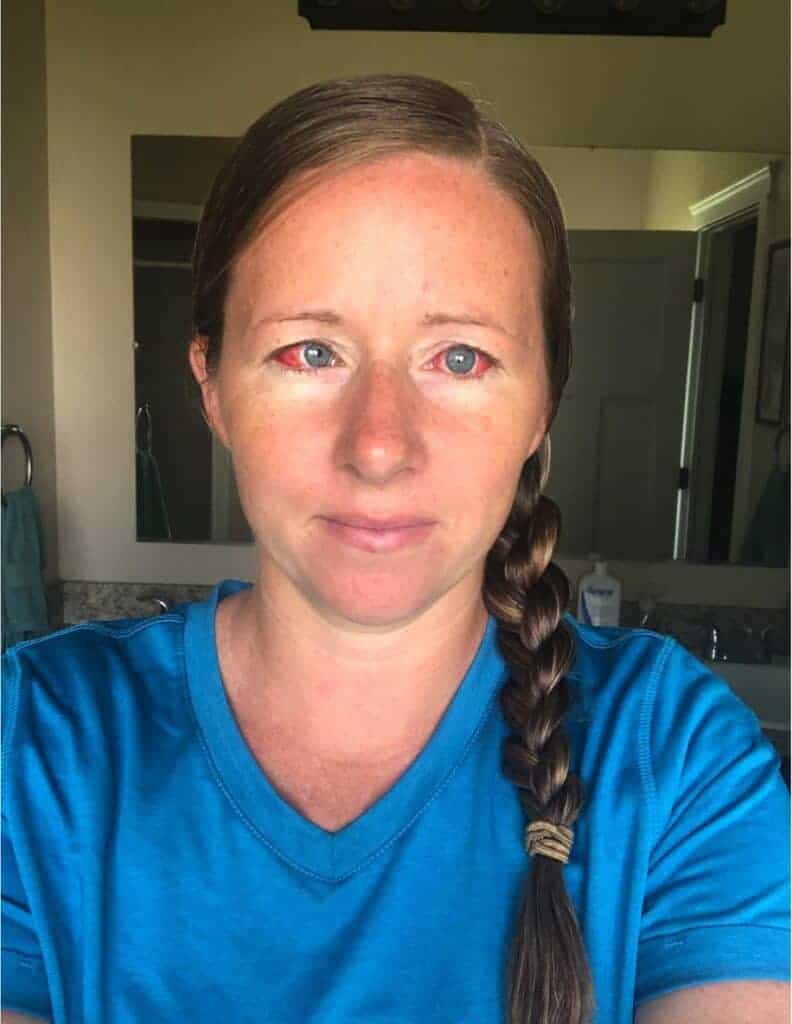
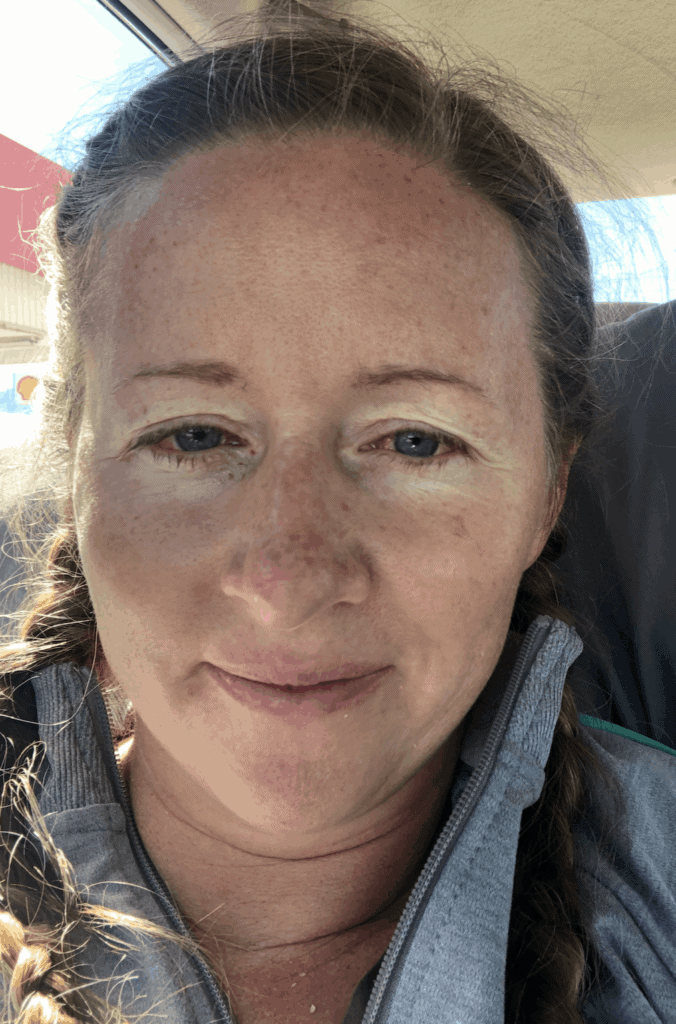
Being able to adjust up to a week later takes out some of the guess work and reduces the need for additional eye operations in the future.
Why Don’t Some Surgeons Use Adjustable Sutures?
Some surgeons argue that adjustable sutures are not worth the discomfort to the patient during the procedure for adults, or having to go under anesthesia a second time for children.
I will admit, I was NOT a fan of the procedure at all. It was pretty awful.
Over the 6-8 weeks following surgery, and even months later, eyes continue to adjust and move. Eye surgeons are chasing a moving target and some believe that trying to make adjustments without knowing where the eyes would settle in the end isn’t useful.
For example, let’s say a patient had 25 degrees of exotropia and the surgery moved them to 15 degrees of esotropia. Maybe over the 6-8 weeks following surgery the eyes would shift and settle 15 degrees back out making them perfectly straight. But if the surgeon had made the adjustment and made them perfectly straight they could have still moved 15 degrees out and the patient would be left with unaligned eyes.
It’s a theory, unfortunately there haven’t been any randomized controlled trials (good research studies) on the subject because it’s too hard to decide what is considered a “success” since it is so different for each patient.
What Studies Have been Done on Using Adjustable Sutures? Do They Work?
While “there have been no radomised controlled trials on the use of adjustable sutures,” there are statistics based on how many people require an additional surgery with or without suture adjustment (George). It is tough to base too much on these statistics because some may choose not to reoperate even if the alignment is not good, and others choose to have another surgery even if the alignment is good because of double vision.
But for our purposes, I think the statistics are useful. “Overall, around 40-50% of patients require adjustments postoperatively.” Most of the patients that have adjustments made are adults.
Of patients who had strabismus surgery, there was “a reoperation rate of 27% in the nonadjustable suture group as compared to 8.5% in the adjustable suture group” (George).
I will take getting sutures adjusted and decreasing my chance of needing another surgery by 20% any day! To me, that is a huge difference. The surgery isn’t a pleasant experience that I’m interested in repeating often.
What is the Actual Suture Adjustment Procedure Like?
I would like to preface this by saying that I am a huge baby. I have passed out multiple times during my pregnancies when the nurse struggles to get the IV in on the first try. I have even passed out when they were just drawing blood one time…it did take the nurse 4 tries, but still, I have a very strong physical response to being poked.
I am never hyperventilating or freaking out or anything, I actually feel really calm, I also feel my body slowly shutting down from my toes and moving up to my head until everything sounds like I’m under water and I’m out. haha. It is actually a little annoying to me, I wish that I wasn’t such a baby!
So when you read this, know that not everyone will respond the same way that I did.
My experience involved a 3 hour drive to Salt Lake City, UT where my surgeon is located with my mom. We even got to stop in for a quick visit with my sister which helped immensely with calming my nerves. Laughing and joking was the medicine I needed.
I was SO terrified about this part of the surgery. I spent the night before having nightmare after nightmare about how horrible it was going to be and I was all nerves. Partially because I didn’t think he would be able to fix the turn, and partially because I knew I would be awake while he cut into my eye.
I didn’t need to worry about him fixing it, he did a fantastic job and was able to adjust an additional 20 degrees which I thought was incredible! But the cutting into my eye part was pretty much as bad as I had expected.

Basic Check-Up With the Nurse
The nurse, at least I think she was a nurse, came in and she did a basic vision check. I read letters off the chart and tried to see the stupid fly float, which I couldn’t. I actually did see one of the dots floating for the first time in my life which completely shocked me!
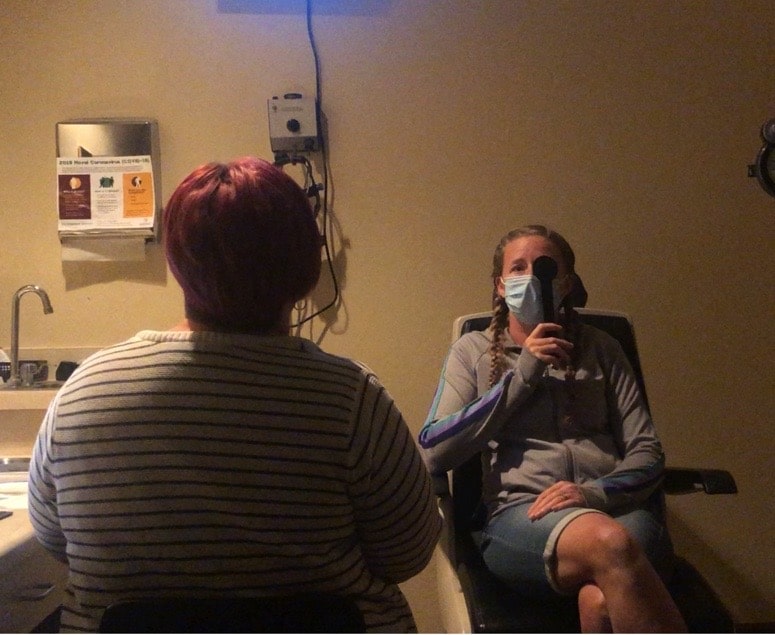
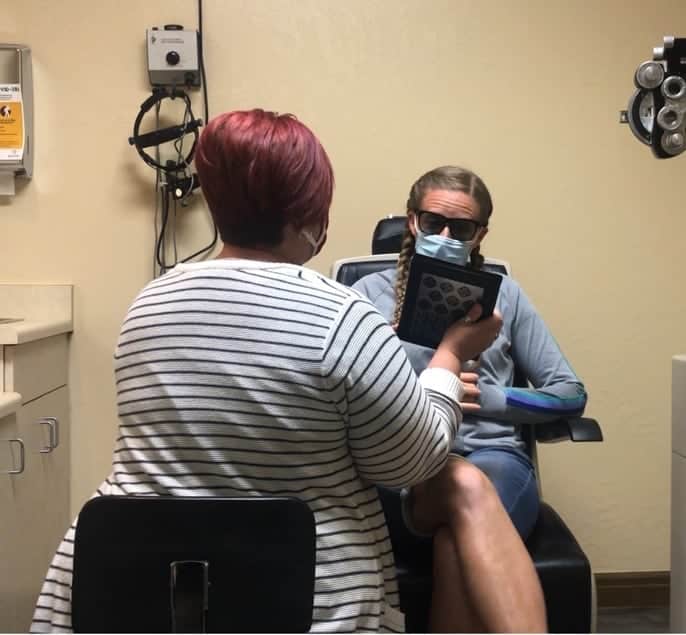
Everything checked out just fine so she left and sent in the next pro. Every time the door opened, I was so relieved that it wasn’t the surgeon yet. Failing at the stereo tests was a walk in the park in comparison. haha
Measurements With the Orthoptist
Next, Dr. Ryan came in. He is a literal ninja at checking measurements. He puts a prism in front of one eye and then covers and uncovers my eyes to see if they jump. He changes prisms until my eyes don’t jump and he knows he has found the degree of turn. Even with all my irregular eye movements, he can about guess by just looking and then confirms with the prism.

He checked the turn at near, far, up, down, and from the sides and was very meticulous about this part. I measured at 25 diopters of esotropia. Dr. Ryan said that my eye would adjust over the next several months, but not that much so we would need to do the suture adjustment to hopefully get my number down between 5 and 10 diopters.

I was shocked to learn that he would be able to adjust that much. I thought that they could maybe adjust 5 or 10 degrees so I was so bummed and thought that my eye was just going to stay turned in. Luckily, I was wrong. He was easily able to adjust 20 degrees.
The Procedure With the Surgeon
Dr. Petersen came in and we chatted a bit about the benefits of adjustable sutures and I got to ask a few questions about the recovery, and then he jumped right in.

Parts of this procedure reminded me of being at the dentist. He had his sterilized tools all set up and ready to go and I sat in a fancy chair that can lean back.

Then he numbed my eyes and when it started to settle in I felt a little light headed, just like I do at the dentist’s office as the numbness starts to course through my veins.

The numbing eye drops stung just a tiny bit and worked very very quickly, within 30 seconds I was already feeling the numbness when I blinked. Once he started working, I couldn’t feel any pain, but there was definite tugging and pulling, which felt similar to dental work.
The biggest difference, though, was that I could see all the instruments coming in and out of my eye and that wasn’t pleasant. I could still talk though, so that was a plus…although I wasn’t feeling particularly conversational at that point. I focused on a spot on the wall and tried to just ignore the instruments and that helped quite a bit.
The other difference was that it was SO quiet in there. No tools screaming or water spraying. I was just left to my own thoughts about what was happening. I made it about 5 minutes in before I started feeling like I was potentially going to pass out.
I casually mentioned that I felt like I was on my way to passing out in a few minutes. I started taking deep breaths in and out through my nose and it just wasn’t helping enough. After about another minute I told him I was definitely going to pass out soon because my hearing was getting weird.
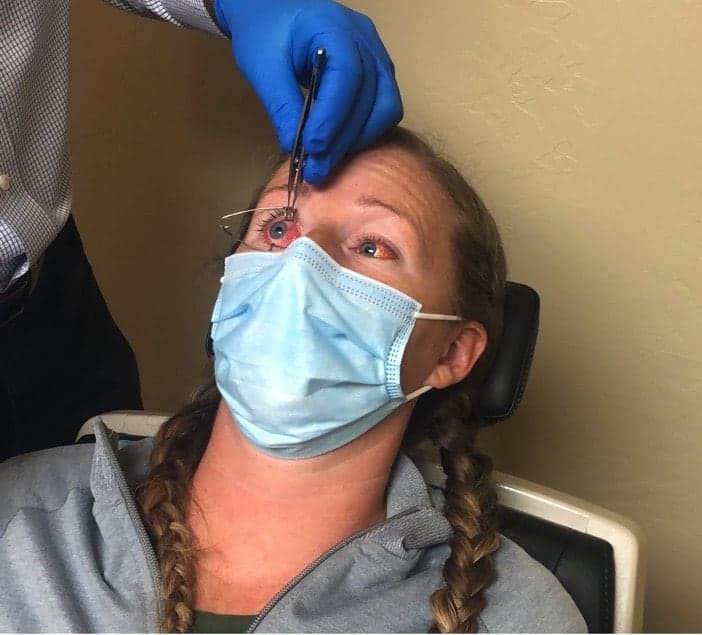
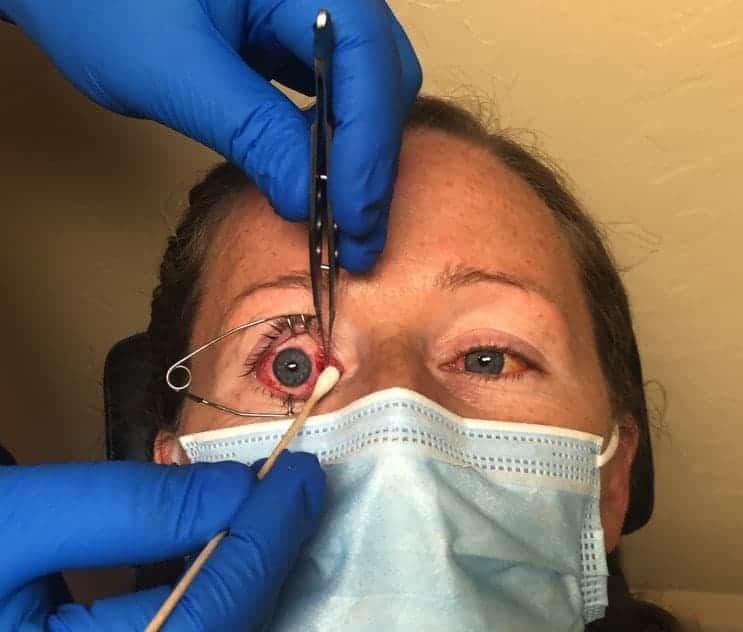
He stopped, leaned my chair back and we waited until my coloring normalized and I could feel myself under control. The moment he went back in it all came back and I knew we needed a different solution.
My mom was there and she came to the rescue with Netflix and The Office. She turned on an episode and as soon as I started laughing, I felt fine. When there were more boring parts I could feel myself slipping back into the passing out zone, but then someone would say or do something funny, all three of us would laugh, and I immediately felt better.
Laughter is actually the best medicine!
After Dr. P was happy with the adjustment he needed me to sit up to check the alignment and I felt totally fine laying down, but as soon as I sat up I felt myself going downhill fast and had to lie down immediately. We waited several minutes and tried again and I just couldn’t keep consciousness so he tested the alignment with me lying back completely.
I was measuring at 6 degrees of esotropia so he was very happy and sewed me back up. Generally, with strabismus surgery, the eyes will slowly move outwards 5-10 degrees in the 6-8 weeks following surgery so leaving it slightly over-corrected is the best option for success in most cases.
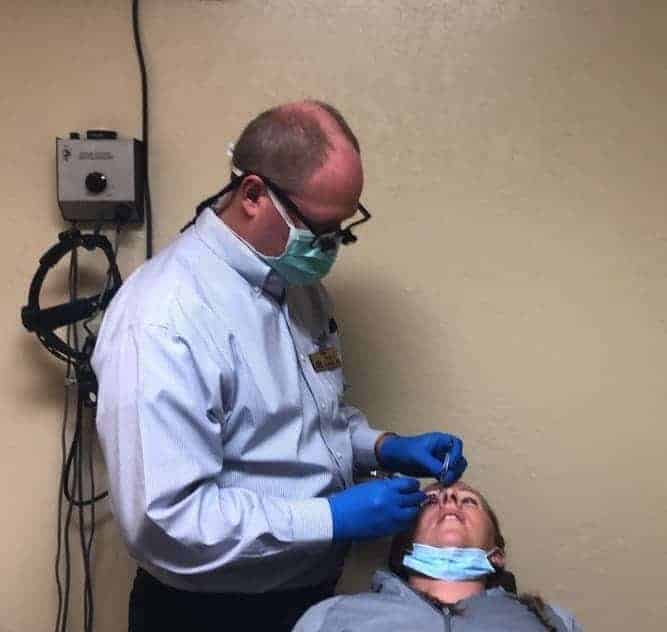
We waited for what seemed like forever and I still couldn’t sit up for more than about 20 seconds before getting super woozy. I was starting to get so annoyed because even though the procedure was over, I couldn’t leave because I wasn’t able to sit or even stand up.
After about 20 minutes I just asked for a wheelchair and I slouch/lyed down while they pushed me out to my car. It took about 2 hours for me to be able to really sit up without feeling light headed.
I have never experienced something like that before so it was so unusual. Dr. Peterson explained that I just have a super strong vagal response. Everyone has this response to stress, but some experience the symptoms more strongly, which I obviously do.
I highly recommend going prepared with something to listen to that is very captivating. My procedure took about 45 minutes, but could have been closer to 15-20 if I hadn’t had so much trouble staying conscious.
What is the Recovery from Suture Adjustment after Strabismus Surgery Like?
The recovery was so much different for me than the actual surgery. Mentally, I was 1000% better because I was able to keep one eye open and still live a pretty normal life. My eyes were much more straight so I wasn’t so paranoid and concerned about whether or not the surgery was a success.
Physically, the pain was very similar to the surgery, but didn’t last quite as long. My right eye went back to being very sore, sensitive to light and I wanted to keep it closed all the time, but it only lasted a few days. I actually went camping (in a camper) 4 days after the suture adjustment and it went pretty well.
I wore my super attractive ice pack as a patch for a few days and was up and about much more than I had been with surgery. The tricky part was that I continued using my left eye which meant I was moving my right as well (they track together). Moving the affected eye was so painful and I had to lay down and nap every day to try to give it a break.

I experienced pretty severe dizziness and visual confusion after the original surgery because my eyes were so misaligned, but after the surgeon adjusted my sutures, the dizziness pretty much went away and I was able to navigate much more easily.
The redness, swelling, weeping and itching all followed a similar course to how things went for the original surgery. My right eye just stayed about one week behind my left.
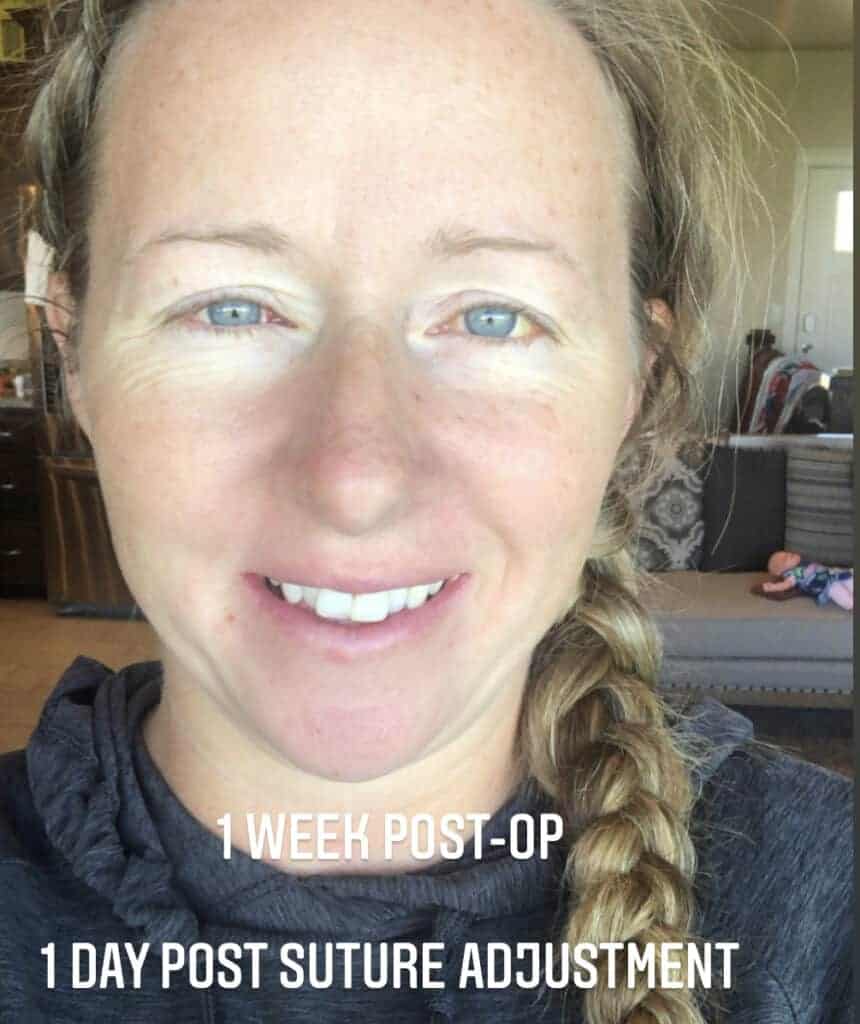
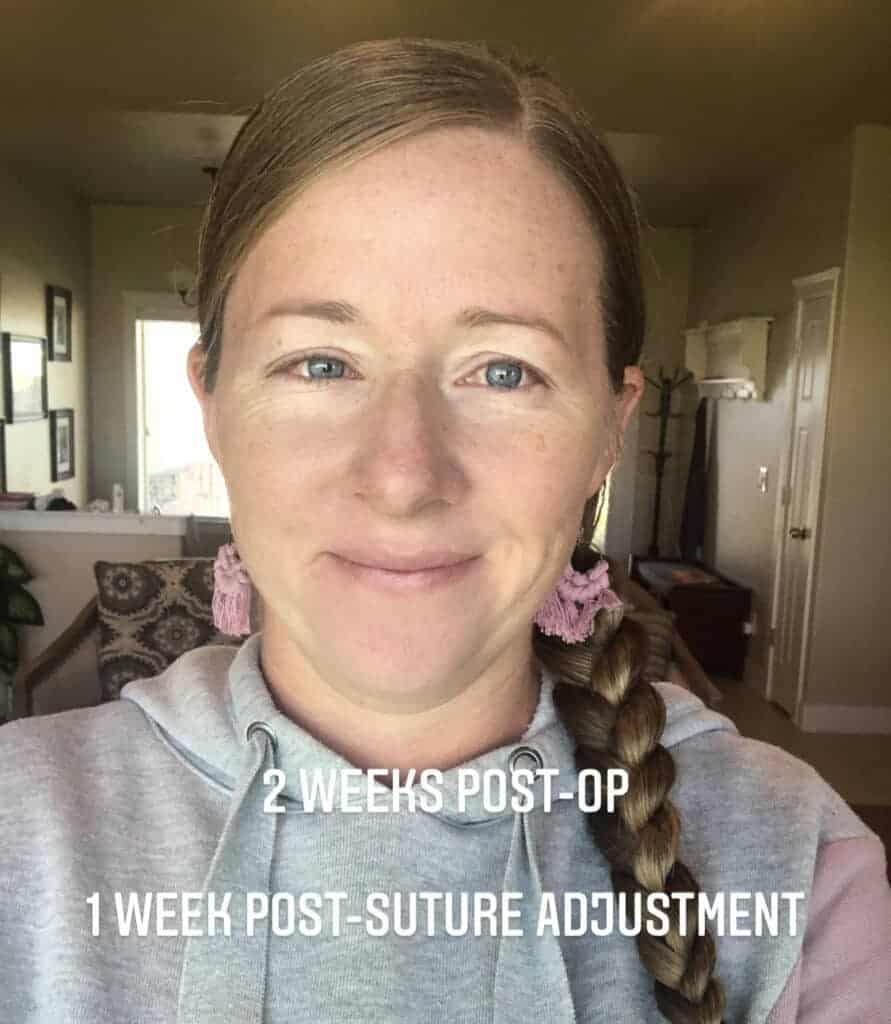
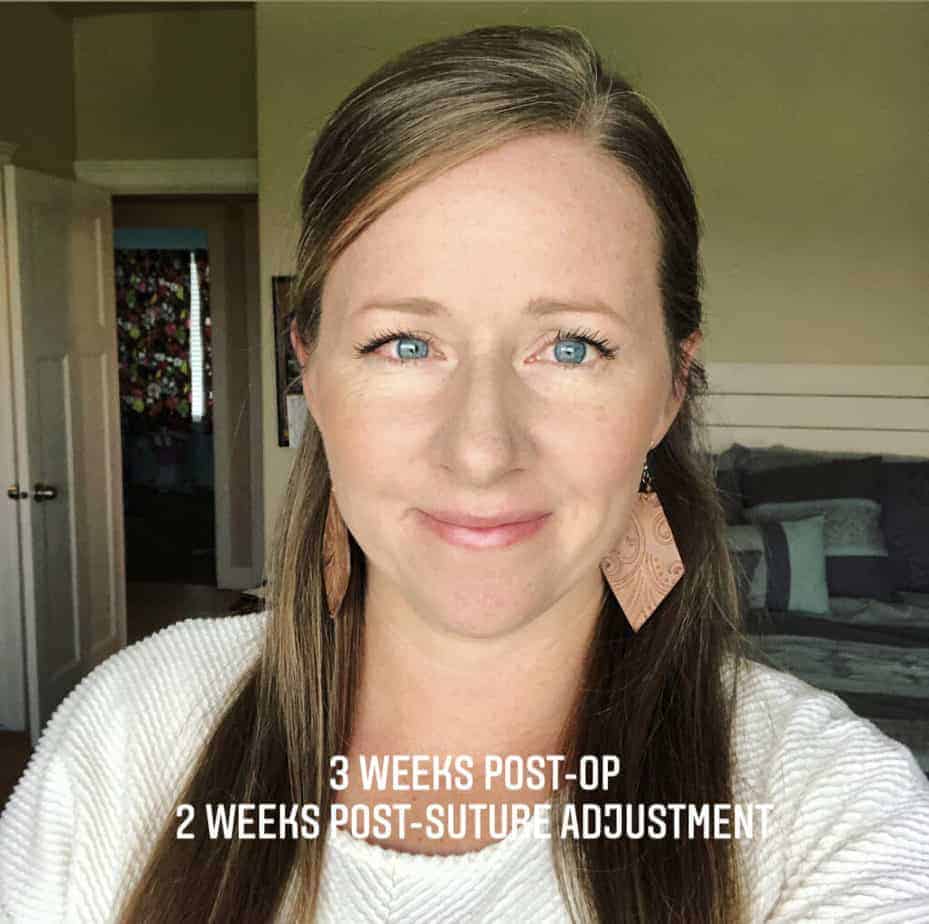
The swelling and weeping only stick around for the first 2-3 days before they get significantly better. The redness improves daily and by day 10 it’s light enough that most people wouldn’t notice it. Around that same time they start to itch like crazy for a few days and then the improvements just keep coming.
After 2 weeks I started wearing eye make-up again without any trouble. I tried swimming 4 weeks after and the chlorine was very irritating to my eyes and brought back all the redness that had been long gone. My surgeon told me swimming was safe 2 weeks after, but whether or not it was safe, it was definitely itchy and uncomfortable for the next 12-24 hours.
Visually, I’m still improving. My peripheral vision is getting better every day and I’m not experiencing double there. I experience some central vision issues when I’m looking into the distance still. Mostly, just double of specific items, not the whole scene. For example, if I’m riding in the car I will see one road, but two of the same car at times.
It is getting better, but will require probably 6-12 more months of vision therapy to make everything single and clear. Read more about my vision therapy over here.
Overall, my surgery and suture adjustment are considered a success because my eye turn went from 35 degrees to 6 degrees. I still have a ways to go, but my amazing surgeon got me so much closer to my goal!

Now that I am almost 5 weeks out, it is easy to say that it isn’t too bad and the recovery goes quickly, but while that is true, it was also pretty miserable for a few weeks. Worth it, but not something I’m interested in experiencing very often.
Please comment and let me know if you have any other questions and I will be sure to answer them. Good luck!
Related Questions
How long does it take for my eyes to settle after strabismus surgery?
After strabismus surgery the eyes continue to move and change, that is the nature of strabismus unless you are able to get the eyes working together, Although they can slowly move over the years, most of the major adjustments and movements will happen in the first 6-8 weeks after surgery and/or suture adjustments.
How long after Strabismus Surgery will I be able drive?
There is a range here, but the absolute minimum is 24 hours. If both eyes are operated on, you will need at least 5-7 days as your eyes will be sore and very sensitive to the outside light and it’s difficult to keep them open for extended periods of time. Day driving comes first and any double vision can be mitigated by wearing a patch. Night and freeway driving take longer, 1 week for some, 1-2 months for others.
Sources
George, N. Adjustable sutures: who needs them?. Eye 17, 683–684 (2003). https://doi.org/10.1038/sj.eye.6700466
